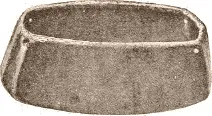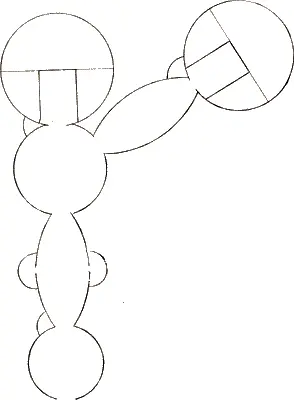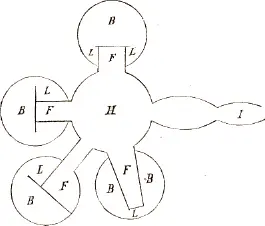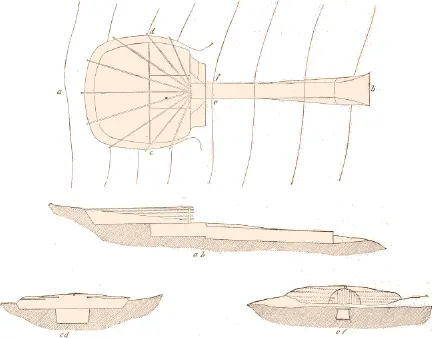The edge of the bed is formed by a long pole. The surface of the snowbank which forms the foundation for the bed is covered with pieces of wood, oars, paddles, tent poles, &c. These are covered with a thick layer of shrubs, particularly Andromeda tetragona . Over these numerous heavy deerskins are spread, and thus a very comfortable bed is made.
According to Parry the arrangement in Iglulik is as follows (II, p. 501):
The beds are arranged by first covering the snow with a quantity of small stones, over which are laid their paddles, tent poles, and some blades of whalebone; above these they place a number of little pieces of network made of thin slips of whalebone, and lastly a quantity of twigs of birch and of the Andromeda tetragona . ***The birch, they say, had been procured from the southward by way of Nuvuk. ***There deerskins, which are very numerous, can now be spread without risk of their touching the snow.
At night, when the Eskimo go to bed, they put their clothing, their boots excepted, on the edge of the platform under the deerskins, thus forming a pillow, and lie down with the head toward the entrance. The blankets (qipiq) for their beds are made of heavy deerskins, which are sewed together, one blanket serving for a whole family. The edge of the blanket is trimmed with leather straps.
On the side benches in front of the bed is the fireplace, which consists of a stone lamp and a framework from which the pots are suspended (see Fig. 493). The lamp (qudlirn), which is made of soapstone, is a shallow vessel in the shape of a small segment of a circle. Sometimes a small space is divided off at the back for gathering in the scraps of blubber. The wick consists of hair of Eryophorum or of dried moss rubbed down with a little blubber so as to be inflammable. It is always carried by the women in a small bag. The whole vessel is filled with blubber as high as the wick, which is spread along the straight side of the vessel. It requires constant attention to keep the desired length burning without smoking, the length kindled being in accordance with the heat or light required. The trimming of the wick is done with a bit of bone, asbestus, or wood, with which the burning moss is spread along the edge of the lamp and extinguished or pressed down if the fire is not wanted or if it smokes. At the same time this stick serves to light other lamps (or pipes), the burnt point being put into the blubber and then kindled. Sometimes a long, narrow vessel stands below the lamp, in which the oil that drops from the edge is collected.
In winter the blubber before being used is frozen, after which it is thoroughly beaten. This bursts the vesicles of fat and the oil comes out as soon as it is melted. The pieces of blubber are either put into the lamp or placed over a piece of bone or wood, which hangs from the framework a little behind the wick. In summer the oil must be chewed out. It is a disgusting sight to see the women and children sitting around a large vessel all chewing blubber and spitting the oil into it.

Fig. 494. Ukusik or soapstone kettle.
The frame of the fireplace consists of four poles stuck in the snow in a square around the lamp and four crossbars connecting the poles at the top. From those which run from the front to the back the kettle (ukusik) is suspended by two pairs of strings or thongs. It is made of soapstone and has a hole in each corner for the string. The kettle which is in use among the eastern tribes has a narrow rim and a wide bottom (Fig. 494), while that of the western ones is just the opposite. Parry, however, found one of this description in River Clyde (I, p. 286). When not in use it is shoved back by means of the strings. Since whalers began to visit the country a great number of tin pots have been introduced, which are much more serviceable, the process of cooking being quickened.
On the top of the frame there is always a wood or bone hoop with a net of thongs stretched across it (inetang). It serves to dry clothing, particularly boots, stockings, and mittens, over the fire. In the passage near the entrance to the hut there is frequently a small lamp (adlirn), which is very effective for warming the cold air entering through the door, and in the remotest corner in the back of the hut there is sometimes another (kidlulirn). When all the lamps are lighted the house becomes warm and comfortable.
Two small holes are frequently cut in the snowbank which forms the ledge, at about the middle of its height (see Fig. 492 a ). They are closed with small snow blocks, each of which has a groove for a handle, and serve to store away anything that must be kept dry. At night the entrance of the inner room is closed with a large snow block, which stands in the passage during the day.

Fig. 495. Plan of double snow house.
These huts are always occupied by two families, each woman having her own lamp and sitting on the ledge in front of it, the one on the right side, the other on the left side of the house. If more families join in building a common snow house, they make two main rooms with one entrance. The plan of such a building is seen in Fig. 495.

Fig. 496. Plan of Iglulik house. (From Parry II, p. 500.)

Fig. 497. Plan of Hudson Bay house. (From Hall II, p. 128.)
The plans of the Iglulik and Hudson Bay houses are different from the one described here. The difference will best be seen by comparing the plans represented in Fig. 496 and Fig. 497, which have been reprinted from Hall and Parry, respectively, with the former ones. Among the eastern tribes I have never seen the beds on the side of the passage, but always at the rear of the house.
Besides these snow houses a more solid building is in use, called qarmang. On the islands of the American Archipelago and in the neighboring parts of the mainland numerous old stone foundations are found, which prove that all these islands were once inhabited by the Eskimo. It has often been said that the central tribes have forgotten the art of building stone houses and always live in snow huts. At the present time they do not build houses, but cover the walls of an old hut with a new roof whenever they take possession of it. There is no need of any new buildings, as the Eskimo always locate in the old settlements and the old buildings are quite sufficient to satisfy all their wants.

Fig. 498. Plan and sections of qarmang or stone house.
Those in good condition have a long stone entrance (ka´teng) (Fig. 498), sometimes from fifteen to twenty feet long. This is made by cutting an excavation into the slope of a hill. Its walls are covered with large slabs of stone about two and a half feet high and three feet wide, the space between the stone and the sides of the excavation being afterwards filled up with earth. The floor of the passage slopes upward toward the hut. The last four feet of the entrance are covered with a very large slab and are a little higher than the other parts of the roof of the passageway. The slab is at the same height as the benches of the dwelling room, which is also dug out, the walls being formed of stones and whale ribs. The plan of the interior is the same as that of the snow house, the bed being in the rear end of the room and the lamps on both sides of the entrance. The floor of the hut is about eight inches higher than that of the passage. The roof and the window, however, differ from those of the snow house. In the front part of the hut the rib of a whale is put up, forming an arch. A great number of poles are lashed to it and run toward the back of the house, where they rest on the top of the wall, forming, as it were, the rafters. The whole curve formed by the rib is covered with a window of seal intestines, while the poles are covered with sealskins, which are fastened in front to the whale rib. At the other end they are either fastened to the ribs in the wall or, more frequently, are steadied by stones. The roof is covered with a thick layer of Andromeda , and another skin, which is fastened in the same way, is spread over both covers. This kind of hut is very warm, light, and comfortable. The stone banks forming the bed are covered as already described.
Читать дальше

















